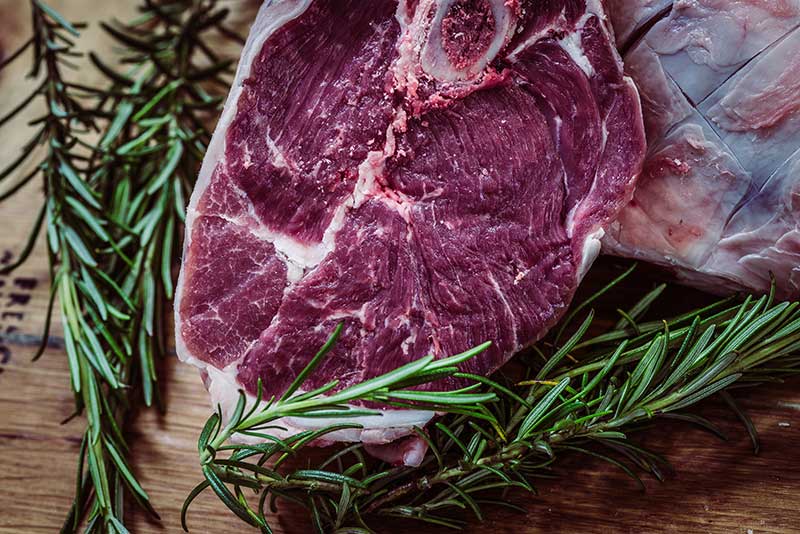The customer service team is always listening, taking notes, and quantifying complaints to ensure our products are continually improved. Due to selling directly to you, the customer, via Amazon, we can use product reviews to help us improve our existing products or help further development of new products.
Table of Contents
For meats and other foods to remain safe for consumption during storage, the proper precautions need to be taken. Humidity in food processing is one of the most important things to consider when it comes to storing meat and keeping microorganisms from thriving in a meat processing environment.
Below, we have discussed how humidity affects meat production and storage, tips to control humidity levels during food processing at home with Indoor Thermometer & Hygrometer, and a few other factors that could negatively affect food storage.
Potential Dangers in Improper Meat Processing and Storage
1. Microorganism Growth
If meat isn’t processed and stored properly, microorganisms could begin to grow. These microorganisms include harmful bacteria, viruses, and various types of fungi that can be dangerous to consume.
If left to thrive in a food processing environment, microorganisms begin to spoil meat products. Once this happens, the meat is deemed unsafe for consumption and must be properly disposed of rather than sold or put on the shelves.
2. Decreased Product Quality and Shelf Life
Even if microorganisms don’t grow and thrive, improper meat processing and storage can cause the quality of the food to be less than ideal. If care isn’t taken to control the meat processing environment’s humidity, temperature, and moisture levels, then the meat can begin to spoil quicker than it would have otherwise.

3. Breakdowns in Packaging
The packaging is an extremely important part of properly storing meats. It protects the food from contaminants that may be on the surfaces it comes into contact with, leaving the meat safe and of high quality.
If meats aren’t stored carefully, then their packaging can begin to break down. This leaves the food more susceptible to microorganisms growth, coming into contact with unsanitary surfaces, and spoilage.
How Humidity Affects Meat Processing and Storage
When it comes to storing and processing meat as safely and effectively as possible, special attention must be paid to the humidity levels in the food processing environment. When humidity is not controlled, the meat is left at risk for the dangers we just discussed: microorganism growth, decreased product quality and shelf life, and breakdowns in packaging.
Microorganisms, such as the harmful bacteria that leave meat unsafe for consumption, thrive in environments where humidity is not controlled. High humidity levels can increase moisture on the meat, allowing these bacteria to grow rapidly.
In addition to microorganism growth, the unregulated humidity can cause meat packaging to breakdown as it becomes increasingly moister. This allows the meats to come into contact with potentially unsanitary surfaces.
Humidity levels don’t just affect the quality of the meat itself, though. Controlling humidity is also an important part of keeping meat processing equipment working efficiently. Without careful humidity control, these machines, equipment, and surfaces are left at risk for high condensation levels, corrosion, and other issues that make them unsafe for workers to operate.
Other 5 Conditions for Microorganism Thriving
1. Moisture
Without moisture, microorganisms are unable to grow and spread. Unfortunately, moisture is naturally present in the muscle tissue of meat, so it is already at high risk for bacteria growth. To combat this, the surfaces of the meats themselves should be kept relatively dry and free from condensation, as this makes it more difficult for microorganisms to survive.
2. Temperature
In order for microorganisms to thrive, they need temperatures typically above 60-degrees F. As temperatures climb, it becomes easier and easier for harmful bacteria to grow and spread on meats, causing them to spoil and become unsafe to eat. To avoid this, meats should be frozen or refrigerated at low temperatures during storage and processing.
3. Oxygen
Free-flowing oxygen allows for microorganisms to grow on the surfaces of meats. During storage, it is important that these surfaces are not exposed to flowing oxygen so that bacteria growth can be kept to an absolute minimum. To achieve this, meat should be vacuum-sealed into its packaging for safe storage.
4. Exposed Surface Area
Harmful microorganisms will not typically grow or survive within the muscle tissue of meat. However, the exposed surface area of a cut of meat provides a perfect place for bacteria to thrive, ultimately spoiling the food and making it unsafe to consume. The more surface area of piece of meat has, the more care it will need when being stored or processed.
5. Degree of Acidity or Alkalinity
Microorganisms thrive best in environments with a neutral pH range, typically somewhere between 5-8. Raw meat falls within this pH range, so it provides the perfect environment for bacteria growth. This can be handled by adding something to the meat to increase its pH level and make it more acidic, like vinegar or citric acid. This makes it far more unlikely that microorganisms will grow during storage.

Common Humidity Control for Meat Products
1. Freeze and Chill Meat and Poultry
Moisture within fresh meat and poultry is natural and necessary. However, high relative humidity levels can cause an abundance of moisture during meat processing and storing, allowing for the growth of microorganisms and causing the meat to spoil. To control this, meat and poultry products should be chilled or frozen. When chilled or frozen, the moisture within the meat and on its surface is no longer a good place for bacteria to thrive.
2. Meat and Poultry Packaging
For the best quality control, meat and poultry should be vacuum-sealed into packaging before being stored or shipped. Vacuum sealing meat products preserve the moisture within the meat but eliminates free-flowing oxygen on the surface, making ot more difficult for bacteria and other microorganisms to grow.
Tips for Humidity Control for Making Meat Products at Home
When processing or storing your own meat products at home, you will want to be sure to carefully control humidity levels so that the meat remains safe for consumption. When storing and processing raw meats, it is incredibly important to monitor humidity levels and prevent the growth of harmful bacteria and other microorganisms. Failure to properly control the humidity in a meat processing environment can be extremely dangerous, allowing the meat to spoil and become unsafe to eat.
What can use to measure humidity? An easy and effective way to do this is to monitor temperate and humidity levels with a ThermoPro Indoor Thermometer & Hygrometer. The thermometer features a digital LCD display, making it easy to read. By placing one of these in your home, you will be able to read the exact temperature and humidity in the room where you are storing meat and adjust it accordingly.









